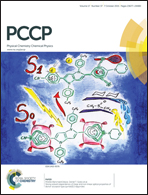Dipolar motions and ionic conduction in an ibuprofen derived ionic liquid
Abstract
It was demonstrated that the combination of the almost water insoluble active pharmaceutical ingredient (API) ibuprofen with the biocompatible 1-ethanol-3-methylimidazolium [C2OHMIM] cation of an ionic liquid (IL) leads to a highly water miscible IL-API with a solubility increased by around 5 orders of magnitude. Its phase transformations, as crystallization and glass transition, are highly sensitive to the water content, the latter shifting to higher temperatures upon dehydration. By dielectric relaxation spectroscopy the dynamical behavior of anhydrous [C2OHMIM][Ibu] and with 18.5 and 3% of water content (w/w) was probed from well below the calorimetric glass transition (Tg) up to the liquid state. Multiple reorientational dipolar processes were detected which become strongly affected by conductivity and electrode polarization near above Tg. Therefore [C2OHMIM][Ibu] exhibits mixed behavior of a conventional molecular glass former and an ionic conductor being analysed in this work through conductivity, electrical modulus and complex permittivity. The dominant process, σα-process, originates by a coupling between both charge transport and dipolar mechanisms. The structural relaxation times were derived from permittivity analysis and confirmed by temperature modulated differential scanning calorimetry. The temperature dependence of the β-secondary relaxation is coherent with a Johari–Goldstein (βJG) process as detected in conventional glass formers.


 Please wait while we load your content...
Please wait while we load your content...